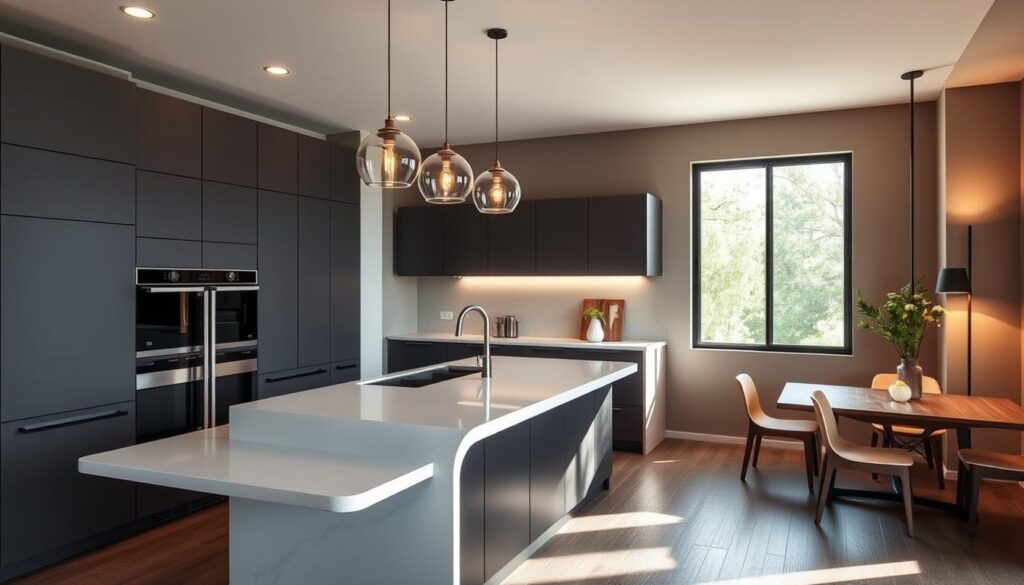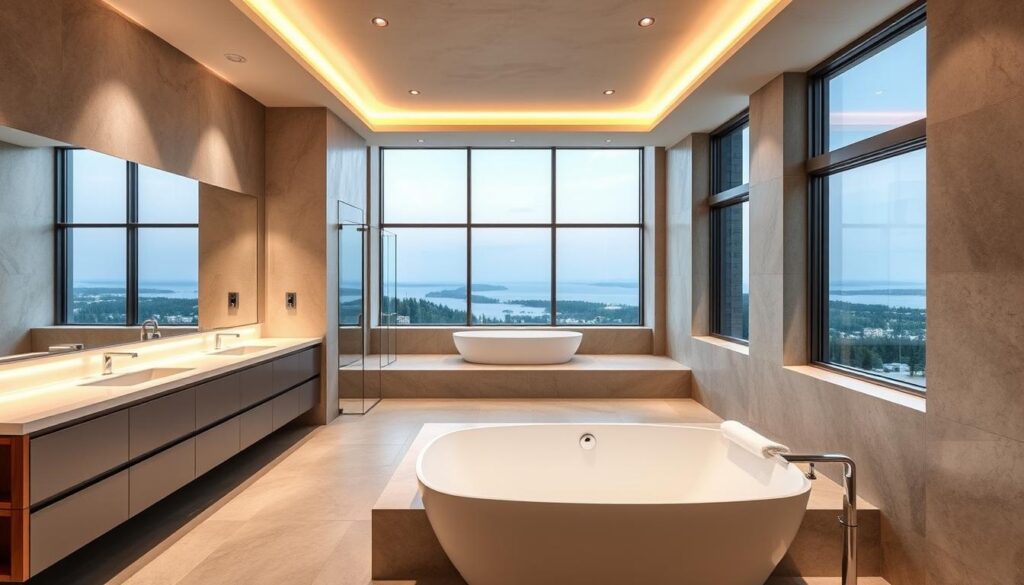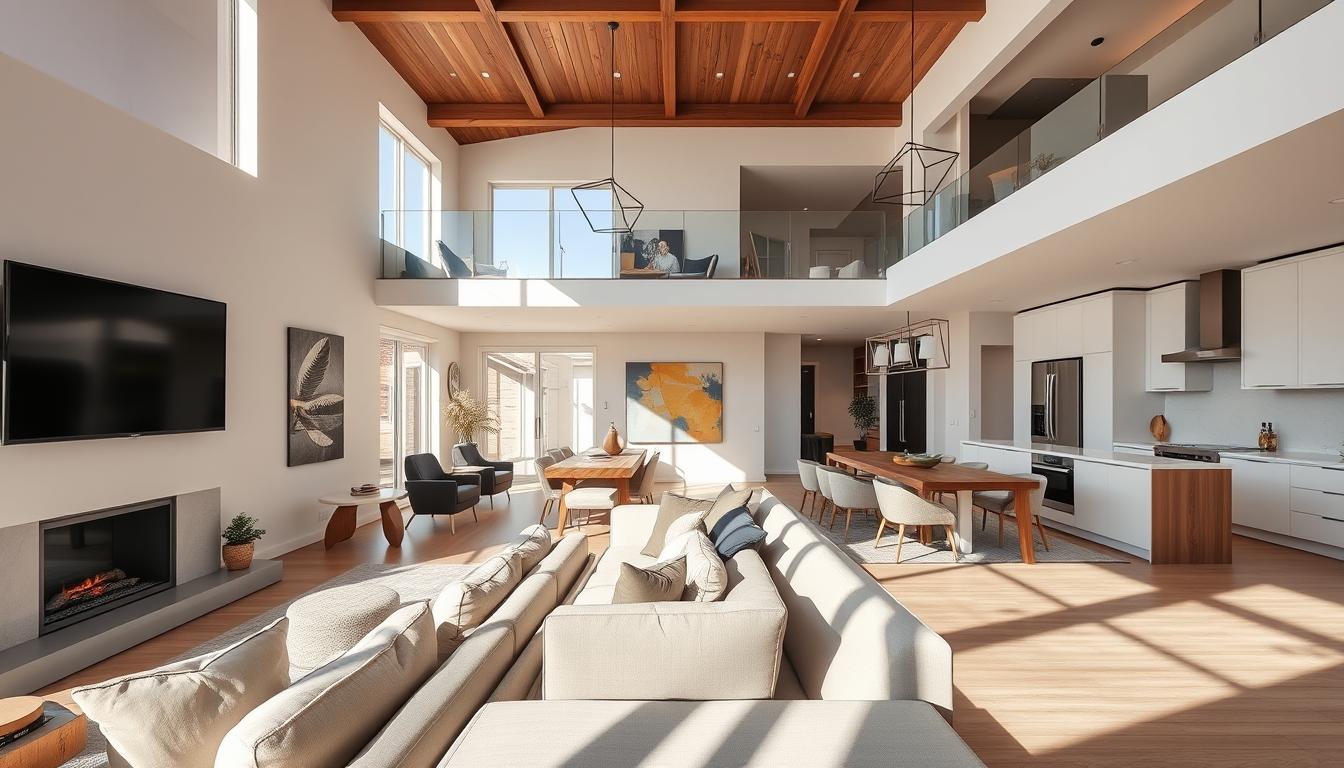Did you know split-level homes were once the height of modern living? Their unique layout and multiple levels offer both challenges and chances for creativity. At Style by Emily Henderson, we find inspiration in making these spaces stylish and functional.
We can make our home look better by using the right design ideas. For example, using the same materials on different levels can make the space feel connected. Experts at EPJ Code suggest this. Adding vertical lines, continuous visual lines, and functional entryways can turn our bi-level home into a stylish and cozy space.
Key Takeaways
- Create a functional entryway with a mudroom treatment.
- Use vertical elements to draw the eye and create a sense of height.
- Incorporate materials consistently across different levels.
- Float furniture to open up walking paths and make spaces feel larger.
- Create a continuous visual line between rooms with art or draperies.
Understanding Bi-Level Homes
Bi-level homes have multiple levels, offering both benefits and challenges. It’s key to grasp their design, features, and advantages.
What is a Bi-Level Home?
A bi-level home, also known as a split-level or split-entry home, has multiple levels. The main living areas are on two levels. This design helps separate different parts of the house, improving flow.
These homes became popular in the mid-20th century. They were a way to add more space to smaller lots. Their design and functionality make them appealing to many.
Key Features of Bi-Level Houses
Bi-level houses stand out with their unique features. These include:
- Multiple levels, often with the main living area on two levels.
- Steps that subtly raise the kitchen or dining area, leaving the living room slightly recessed or sunken.
- A design that allows for a natural separation between different areas of the house.
These features give bi-level homes their special character. They are both functional and beautiful.
Advantages of Bi-Level Living
Bi-level living has many benefits. These include:
| Advantage | Description |
|---|---|
| Natural Separation | Bi-level homes provide a natural separation between different areas of the house, creating a more structured flow. |
| Maximized Space | The multi-level design allows for more square footage on smaller lots, making it an efficient use of space. |
| Design Flexibility | Bi-level homes offer a unique blend of design and functionality, allowing homeowners to express their personal style. |
Understanding bi-level homes’ characteristics and benefits helps homeowners. It enhances their living experience.
Designing the Entryway
The entryway of a bi-level home is more than just a passageway. It’s a chance to make a lasting impression. It’s the first thing visitors see, so it’s key to make it welcoming and stylish.
Welcoming Elements for Smarter Entrances
To make a smarter entrance, add elements that are both functional and stylish. A bench or a console table offers a place to sit and a spot for belongings. Hooks for coats and bags help keep things organized.
- A stylish light fixture to illuminate the area
- A mirror to create the illusion of more space
- A small table or shelf for keys and mail
Incorporating Storage Solutions
Adding storage solutions is vital for a clutter-free entryway. Use cubbies or shelves for shoes, bags, and accessories. This keeps the area tidy and makes the space more functional.
- Built-in shelving units for a customized look
- Baskets or bins for storing small items
- A storage bench that doubles as a seating area
Color Schemes for Bi-Level Interiors
In bi-level homes, picking the right colors is key. It helps connect the different levels and makes the space feel unified. We’ll look at how to pick colors that work well together and enhance the area.
Choosing a Cohesive Color Palette
A good color scheme can tie together a bi-level home’s various areas. This creates a smooth flow between levels. Here are some tips to help:
- Choose a main color to use everywhere for a sense of unity.
- Use a neutral color for most of the space. Add pops of color with furniture and decor.
- Think about the natural light in each area and how it changes color.
Using a consistent color scheme makes a bi-level home feel bigger and more connected. A neutral color palette is great because it’s calming and open. It’s perfect for modern bi-level designs.
Best Colors to Enhance Space
Some colors can make a bi-level home feel bigger or cozier. Here are some popular color choices for bi-level living rooms:
- Soft Whites and Creams: These colors make ceilings look higher and spaces feel open.
- Light Grays: A good choice for both modern and traditional decor, light gray makes rooms seem larger.
- Warm Beiges: These colors add a cozy feel, making spaces in a bi-level home inviting.
For an updated split level interior, add accent colors for depth and style. Blues and greens are calming and bring nature inside. Bold colors like red or orange add energy and vibrancy.
The secret to a great color scheme in a bi-level home is balance and harmony. By picking colors that match each other and the home’s design, we can create a beautiful and welcoming space.
Maximizing Natural Light
Getting more natural light is key in designing bi-level homes. It makes the space feel bigger and more welcoming. Natural light can change how a home looks and feels.
Using the right window treatments is a smart way to get more light. Sheer curtains, blinds, and shades help control light while keeping things private.
Window Treatments that Work Wonders
Choosing the right window treatments is important. Sheer curtains are great because they let sunlight in while keeping things private.
- Sheer curtains or drapes
- Blinds with adjustable slats
- Shades that can be raised or lowered
These treatments not only let in more light. They also help control how much light and heat get in.
Strategic Placement of Mirrors
Mirrors can also help bring in more light. Placing mirrors right can make a room feel brighter and bigger.
| Mirror Placement | Effect on Natural Light |
|---|---|
| Opposite a window | Reflects natural light into the room |
| Adjacent to a window | Amplifies natural light and creates the illusion of a larger space |
| In a narrow hallway | Helps to distribute natural light to areas that may not receive direct sunlight |
As interior design experts say, mirrors can change how a room looks. They make rooms feel bigger and more inviting by reflecting light.
By using these ideas in your bi-level home design, you can make it brighter and more welcoming. It will feel larger and more modern.
Living Room Layout Ideas
Designing the living room in a bi-level home is all about finding the right mix of function and style. This room is often the heart of the home. In bi-level houses, it’s a chance to make a space that’s both welcoming and beautiful.
Balancing Functionality and Style
A good living room is both useful and stylish. Think about using a sectional sofa to set up the seating area. This makes the room look good and still works well for everyday use.
Adding natural light and minimal decor can make the room feel bigger and more inviting. Choosing furniture and decor carefully helps create a space that’s both open and cozy.
Furniture Arrangement Tips for Comfort
The way you arrange furniture is key to making the living room comfortable and easy to move around. Think about the traffic path through the room. Make sure there’s enough room between furniture for easy movement.
- Use a rug to mark the seating area and add warmth.
- Arrange furniture to make conversation circles, which encourage people to talk.
- Don’t fill the room with too much furniture. Choose a few pieces that do many things.
By following these tips, you can make a living room that’s not just stylish but also comfy and practical. It’s great for relaxing and having guests over.
Kitchen Design Inspirations
Bi-level homes present a unique challenge in kitchen design. But, with the right inspiration, you can make a beautiful and functional space. The kitchen is key in any home, and in bi-levels, it’s vital to think about layout and flow.
Choosing between an open concept or a traditional layout is a big decision. Open concept kitchens make the space feel bigger and more connected. Traditional layouts, on the other hand, offer a clear cooking area, perfect for those who like a separate kitchen and living space.
Open Concept vs. Traditional Layouts
Open concept kitchens are trendy in modern bi-level renovations. They blend the kitchen with living areas, creating a spacious feel. But, they might lack the separation needed for a clean cooking area.
Traditional kitchens, in contrast, have a defined cooking space. This is great for homes where cooking is central. Adding a kitchen island can boost counter space and storage, making the kitchen more functional.

Smart Storage Solutions for Bi-Level Kitchens
Smart storage is key in any kitchen, no matter the layout. Think about adding a kitchen island or pantry for more storage. A kitchen island can also add counter space, storage, a sink, or even a cooking range, making the kitchen more useful.
Other smart storage ideas include pull-out shelves, wall-mounted cabinets, and multi-functional furniture. These help keep your kitchen tidy and welcoming for cooking and socializing.
In summary, designing a kitchen for a bi-level home requires careful thought on layout and storage. By picking the right design and smart storage, you can make a kitchen that’s both stylish and practical.
Creating Cozy Dining Spaces
Creating a warm and inviting dining area is key for bi-level homeowners. They love family gatherings and entertaining friends. The dining space in a bi-level home is a chance to mix function with beauty.
Think about the layout and how it ties to the rest of your home. Bi-level home decor often means open-plan living. This makes the dining space a key spot for socializing.
Ideal Dining Room Configurations
The layout of your dining room matters a lot. Choose a dining table that fits the room well. In small spaces, round or oval tables create a cozy feel. Larger rooms can handle rectangular tables.
In modern bi-level design ideas, the dining area often merges with the living room or kitchen. This layout makes the space feel bigger and more connected.
Table and Chair Selection Tips
Picking the right table and chairs is key for a cozy dining space. The table should fit the room and the number of guests. Chairs should be comfy and match the table’s style.
For an updated split level interior, mix modern and traditional furniture. This mix adds depth and character to your dining area.
- Choose a table that is proportional to the room size.
- Select chairs that are comfortable and stylistically consistent with the table.
- Consider the material and finish of the furniture to ensure it complements the overall decor.
By carefully choosing your dining space’s layout and furniture, you can make a cozy and welcoming area. This will enhance your bi-level home’s charm.
Designing Functional Bedrooms
In bi-level homes, bedrooms can be a cozy retreat. The right design makes them both functional and inviting. It’s key to think about the special challenges and chances of the bi-level layout.
We should use space wisely, mainly in upper levels where bedrooms are. Using furniture that does more than one thing is a smart move.
Optimizing Space in Upper Levels
To make the most of space, think about storage beds or dressers. They keep the room tidy and use space well. For more ideas, check out Havenly’s bedroom layout ideas.
Wall-mounted shelves and storage are also great. They clear the floor, making the room feel bigger and more open.
Creative Storage Solutions
Creative storage is key in bi-level home bedrooms. Under-bed storage is a smart use of space. Closet organizers also boost your bedroom’s storage.
Here are some storage ideas that work well:
| Storage Solution | Description | Benefits |
|---|---|---|
| Under-bed storage | Storage bins or drawers under the bed | Uses wasted space, hides clutter |
| Closet organizers | Shelves, drawers, and rods in the closet | Maximizes closet space, improves organization |
| Wall-mounted shelves | Shelves on walls for storage or decor | Clears floor, adds style |
These storage ideas help make your bedroom tidy and calm. For a modern split level remodel, think about how to include these ideas in your design.
Designing bedrooms in bi-level homes with functionality in mind creates beautiful and practical spaces. By optimizing space and using creative storage, we can fully utilize the unique layout of bi-level homes.
Bathrooms in Bi-Level Homes
Bi-level homes have their own challenges when designing bathrooms. But, with the right approach, you can make a beautiful and useful space. The key is to understand the space’s needs and limits.
Maximizing Small Bathroom Spaces
Smaller bathrooms need smart space use. A pedestal sink can make the room feel bigger. Also, a wall-mounted toilet adds to the openness.
Light colors on walls and floors make the space look brighter. Mirrors help make the room seem larger.

Design Trends for Modern Bathrooms
Modern bathrooms aim for a spa-like feel. Adding rain showerheads and heated floors can make it luxurious. These features also boost your home’s value.
Here are some trends for your bi-level home bathroom:
- Use of natural materials like stone and wood
- Incorporation of smart technology for lighting and temperature control
- Minimalist designs that emphasize clean lines and simplicity
Experts say, “A well-designed bathroom is a sanctuary, offering peace from daily life.”
A well-designed bathroom is not just about looks; it’s also about function and comfort.
| Design Element | Benefit |
|---|---|
| Pedestal Sink | Creates a sense of openness |
| Rain Showerhead | Enhances luxury feel |
| Heated Floors | Increases comfort and home value |
By using these design trends and strategies, you can make a bathroom in your bi-level home that’s both stylish and practical.
Effective Use of Décor
Effective décor in bi-level homes can make a big difference. It can make your living space feel cohesive and inviting. By choosing the right artwork and layering textures, you can enhance your home’s look.
Selecting Artwork for Bi-Level Spaces
Choosing the right artwork is key in bi-level homes. It helps tie the different levels together, creating a sense of continuity. Pick pieces that show your personal style and match your home’s décor.
For a modern split-level remodel, go for modern art with clean lines. Traditional homes might look better with classic artwork or family heirlooms.
Layering Textures for Warmth
Layering textures adds warmth and depth to your bi-level living room. Use throw blankets, rugs, and pillows to mix different materials.
For example, a leather sofa with a chunky rug and plush blankets creates a cozy feel. Mixing metallic accents with wood or stone adds visual interest.
| Texture Combination | Effect |
|---|---|
| Smooth leather + chunky rug | Creates a cozy atmosphere |
| Metallic accents + natural wood | Adds visual interest |
| Plush throw blankets + woven pillows | Enhances warmth and comfort |
By using these décor strategies, you can make your bi-level living room stylish and welcoming. Whether you’re looking for inspiration or tips, remember to have fun and be creative with your choices.
Outdoor Spaces and Balconies
Outdoor spaces and balconies in bi-level homes are often overlooked. With careful design, they can greatly improve your living experience. They offer extra room for relaxation, fun, and enjoying nature.
Making the Most of Outdoor Areas
To get the most out of outdoor areas, choose outdoor furniture that’s both useful and looks good. Think about weather-resistant sofas, dining sets, and decorations that show off your style. This way, you can make these areas feel like part of your home.
Outdoor decor is also key. Adding outdoor lighting, planters, and decorative screens can make the space look better and feel cozier. For homes with balconies, using railings or screens with plants can bring in a natural vibe.
Landscaping Ideas for Curb Appeal
Landscaping is vital for making your bi-level home look great from the outside. Try planting colorful flowers, shrubs, and trees that match your home’s look. For outdoor spaces, adding herbs or a small garden can be both useful and pretty.
Good landscaping also helps connect your outdoor and indoor areas. For example, using the same materials or colors for paths and floors can make your home look more unified. Plus, outdoor lighting can highlight your landscaping and make your home stand out.
By focusing on both looks and function in outdoor spaces and balconies, you can make your bi-level home more enjoyable and attractive.
Maintenance and Upkeep
To keep our bi-level homes looking great, regular maintenance is key. It’s not just about cleaning. It’s also about checking for damage, updating fixtures, and keeping everything in good shape.
Practical Tips for Durable Interiors
For interiors that last, use top-quality materials and finishes. These should handle daily life well. Regular checks and upkeep are vital to avoid damage. This is very true for modern split level remodels.
Seasonal Maintenance for Bi-Level Homes
Having a seasonal maintenance checklist is helpful. It should cover tasks like roof checks, HVAC upkeep, and water damage inspections. This keeps our homes looking good and stylish all year round.


